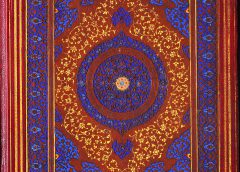
Qat or qat‛ı means “to cut” in the dictionary. Qat‛ı is the art of decoration which is done by gouging out a writing, motif or figure on a paper or leather and then pasting it onto another paper or piece of leather. A work of art done in this way is named “qaatıa” or “muqatta”; its artist is called “qaatı‛” and “qattaa‛”. The part that is gouged from a pattern is called male-carving; the cavity formed thereof is called female-carving. These two figures can be pasted on separate surfaces and then two different paintings can be done. In the past a kind of curved knife or muqraz (scissors) called “nevregen” would be used in this art. Curved embroidery scissors, carving knives and bistouries (scalpels) are used today.
Although it is accepted that paper engraving is an art which originated in Iran, researchers claim that paper and leather engraving were born in China as a folk art about two thousand years ago. Engraved leather book covers which were done by the Uyghur and reached the present day reveal that the paper and leather engraving passed to the Islamic world through Central Asia. Its first examples seen at the time of the Timurid and the Ak Koyunlu in the second half of the 15th century, paper engraving made progress in the Safavid and the Ottoman empires as of the beginning of the 16th century. Among the book arts, the paper engraving art developed based on the special interest from the Ottoman Palace and its circles as of the 16th century; it continued its existence until the beginning of 20th century with a popularity more than what was seen in the Safavid Palace.
Turkish qat‛ı works, which were widely used in the Ottoman empire as of the beginning of the 16th century, made unique progress. They started to be used almost as common as illumination in decoration at the time of Kanuni Sultan Suleiman, when it had its most brilliant era. Therefore, the richness of the motif of the art of illumination and its progress in time are reflected in the art of qat‛ı as well. Two of the important qat‛ı works of that era are the “Divan-ı Ayni” in the Museum of Turkic and Islamic Works (with inventory no TİEM-1926), and the Mathnawi of “Gûy u Çevgân” of Ârifî in the Library of the Topkapı Palace Museum (Hazine, no. 845), both in Istanbul. They are masterpieces of the muqatta writing style which is formed by pasting carved nastaliq letters on different colour papers. Moreover, page borders made with female-carving patterns and leather covers embroidered by carving can be counted among the finest works of art of that time.
Having developed with the popularity it found in the 16th century, paper engraving continued its progress in parallel with the developments in the art branches of illumination and binding in the 17th and 18th centuries. The art of qat‛ı continued its spirit in the 18th century at a time when especially the motifs of flowers thrived. The examples of qat‛ı that started to attract attention in Europe at the end of the 16th century and the beginning of the 17th century became a universal art as a result of the transfer of it by interested western travellers who journeyed the East with the effect of Orientalism. The westerners who adopted this art developed their own style after a while which they called silhouette. In parallel with the decline of classic arts like binding, calligraphy and marbling, the art of qat‛ı has begun to be forgotten. Production of no serious work in this field in the 19th century caused its end. As for today, although few in number, ambassadors of this art – which really needs patience, attention and delicacy – continue their works meticulously.

